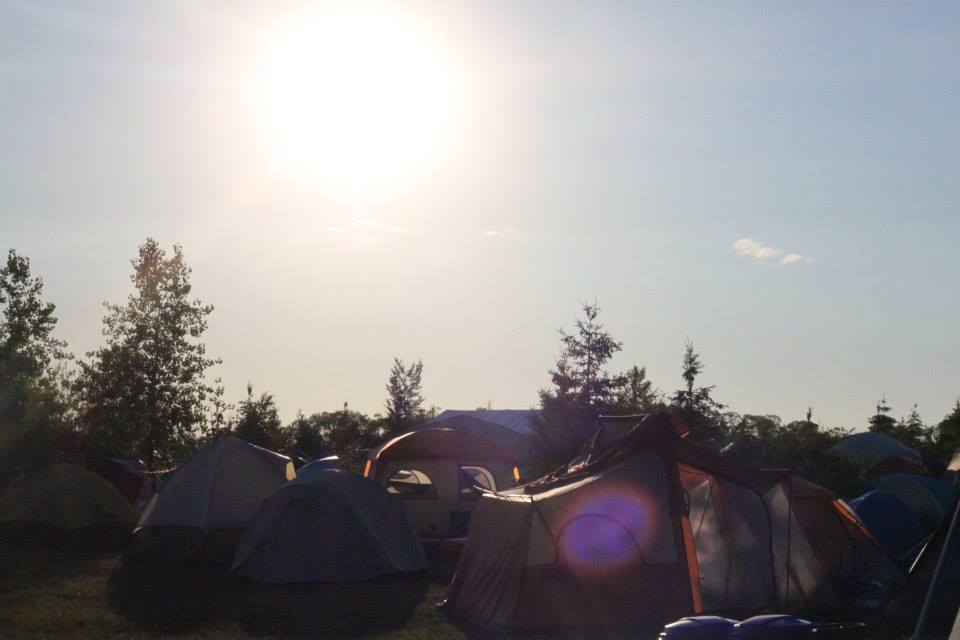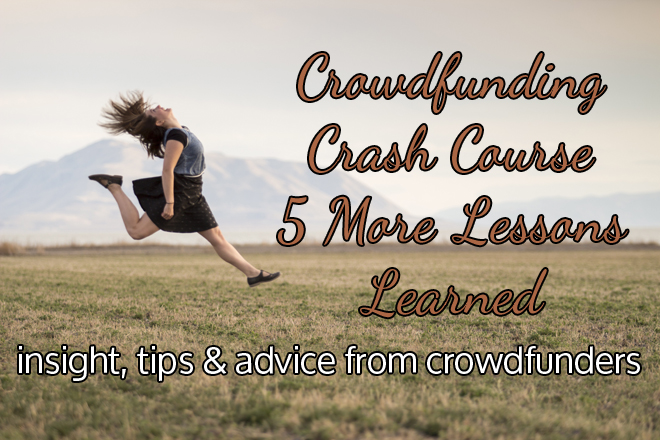July 2015
You're invited to #SocialHour, a monthly Twitter chat about community building & engagement
- by Alyson Shane
Hello everyone!
I'm excited to announce that starting August 11, 2015 I'll be hosting a monthly Twitter Chat called #SocialHour. On the 2nd Tuesday each month we'll have a chance to come together and discuss ideas, challenges, and strategies for growing your audience and increasing engagement on your blog and social media feeds.
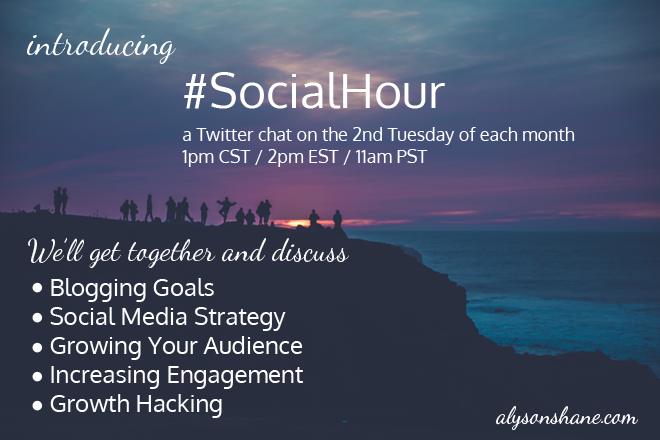
As you know, I'm a big believer in knowledge sharing, and I can't think of a better way for us all to learn and grow together than to make a time to have a chat each month about our challenges, our goals and how we plan to kick some ass that month.
Finding and growing your community can feel overwhelming by yourself, so let's do it together!
How can you join us?
Joining the conversation is easy, all you need is a Twitter account!
Once you're logged in you can follow the discussion by doing a Twitter search for the hashtag #SocialHour. If you get lost just hit up my Twitter account to find the hashtag link again and you'll be right back in the mix.
I'll prepare a handful of questions each month to get the wheels in your head turning and the conversation started, and we'll spent the next hour or so sharing our responses with each other and collaborating together.
I'll be posting questions with Q1, Q2, etc at the beginning, so you can easily keep track of what we're discussing. When you respond, simply add the corresponding number to your answer like so:
A2 My favourite cupcake is red velvet with cream cheese frosting #SocialHour
(great, now I want a cupcake - but you get the drift!)
But don't just reply to my questions, be sure to check out what other people are saying and reply to them as well! I'll also be retweeting some of my favourite contributions, and will help guide the conversation by engaging with everyone as we chat.
Sounds great! What now?
Remember to mark your calendars for August 11th at 1pm CT to join us. I'll be sending out a reminder the day before to my newsletter subscribers, so make sure to sign up so you don't miss out!
I can't wait to start this new project with all of you, and am looking forward to getting to know all of you and helping you find and grow kickass, engaged communities!
xox
Alyson
Crowdfunding Crash Course: Jeffrey Martin - Sphericam
- by Alyson Shane

Jeffrey Martin is a photographer of 360, Gigapixel, and Panoramic photos. He used Kickstarter to successfully fund the his product the Sphericam, a 360º video camera.
Can you briefly describe Sphericam?
Sphericam is the world’s only fully spherical, 360º video camera. It records in 4K, has no blind spots, and can be played back on VR headsets like the Oculus and GearVR, as well as your PC or on your iPad.or VR headset. Jeffrey Martin is a photographer of 360, Gigapixel, and Panoramic photos. He used Kickstarter to successfully fund the his product the Sphericam, a 360º video camera.
Why did you feel that the crowdfunding model was the best way to promote the product
Crowdfunding is a great way to market products that are new to the market, or are still in prototype stages. It’s a great way to raise awareness of your product before it goes to market.
Why and how did you choose Kickstarter over other crowdfunding options available?
Kickstarter has the biggest footprint in the world of crowdfunding, and has a huge community of active members who are always searching the site for new products and ideas to back. Plus the site itself does a great job of marketing and promoting the campaigns.
How big was your budget before you launched your crowdfunding campaign?
Somewhere between $15,000 and $20,000 I’d say. This amount went towards the important stuff that makes a good campaign stand out; namely the video, marketing material and ad purchases, the copywriting for the Kickstarter and website pages, and the creation of the website itself.
How far along was your project before you felt ready to launch a crowdfunding campaign? In hindsight, would you have preferred to be farther along, or to have crowdfunded earlier?
I knew that I needed to have the camera pretty much ready before I launched the campaign, more or less at the complete prototype stage. It needed to be able to take pictures at a high enough quality that I could show people what it was going to look like.
This made my campaign different from other types of campaigns: a lot of campaigns can launch without a prototype-ready product that can be developed after the campaign is completed. A camera is different, though, you need to be able to show people exactly what they’re getting, which you can only do by providing images from the actual camera.
Can you explain how you prepared for and managed your campaign?
I had a lot of media contacts from my days as a photographer, so I made a point to reach out to them and make them aware that I was launching my campaign. I also hired a PR company to handle tasks like pitching journalists and news organizations.
I handled all of the email questions and inquiries, though, which was a huge task. While I guess I could have had someone answer them for me, I think that when you’re a small company just starting out people need to be in direct contact with the founders throughout the campaign. Once you’re a company of 10-15 people, then it’s okay to assign a task like that to someone else, but in the beginning your backers and other people with inquiries need to be hearing from you, the founder.

What tools did you use to market your campaign? Do you feel like you did so successfully, and if not, what could you have done differently?
We ran some Facebook ads which were successful, but we didn’t really scale them up because there wasn’t a lot of margin left over. Kickstarter took theirs and we needed to pay the PR company, so we weren’t able to scale up throughout the length of the campaign.
Overall I feel like we did a good job of promoting our campaign, though I wish we’d had a little more top-level press from sites like the New York Times, but… I guess everyone wishes that sort of thing, so that’s okay.
In retrospect what were your best assets for running this successful campaign? On the other hand, what would you do differently?
I feel that the best asset for our campaign was the production value. It’s the most important part of any campaign, in my opinion, because people are going to judge the quality of your product and your idea based on what they see and hear. By hiring a great copywriter and making a great video we were able to instill confidence in our potential backers.
If I could do anything differently I would have tried to generate a bit more buzz about the campaign before it started, though that’s a slippery slope because you don’t want to exhaust all of your promotional options before the campaign even starts or you won’t be able to keep up momentum and interest for very long. So, I guess it’s better to err on the side of secrecy a little bit, at least before you’re fully ready to go.
What was your biggest challenge during your campaign?
Staying sane! Running our Kickstarter was the most relentless 32 days I’ve ever had. It’s totally non stop, and if you do take a day off -which you can, if you plan- you’ll have so much catching up to do the next day that it might not even seem worth it.
What’s the most valuable advice you could share with aspiring crowdfunders?
Be honest with yourself about what you’re not good at and find people who can help you accomplish those tasks. If you’re no good at understanding analytics for ads, copywriting, budgeting, whatever, it’s better to admit that to yourself and to ask for help, rather than struggle through it and potentially waste your own time.
For example, I could have written some copy for the Kickstarter page and the website but I would have really struggled with it, so I decided to pay someone to do it for me, and they did it the right way. You need to learn to delegate tasks, and to be part of a growing team as things progress.
This post is part of a series! For more interviews and summary posts, check out the Crowdfunding Crash Course page.
How to Go From Novice to Pro: Actionables to Make Your Blog Better
- by Alyson Shane
We live in a world where content is king - the more quality, share-able stuff you publish on your blog increases the likelihood that people will find you and keep coming back.
While this is all well and good, all the great content in the world can't overcome a layout that is difficult to navigate, or physically hurts to look at.
Whether you're brand-new to blogging or feel like it's time to update your blog layout to reflect the savvy, experienced blogger that you are, I've got you covered with some easy actionables to take your blog from "meh" to "yeah!"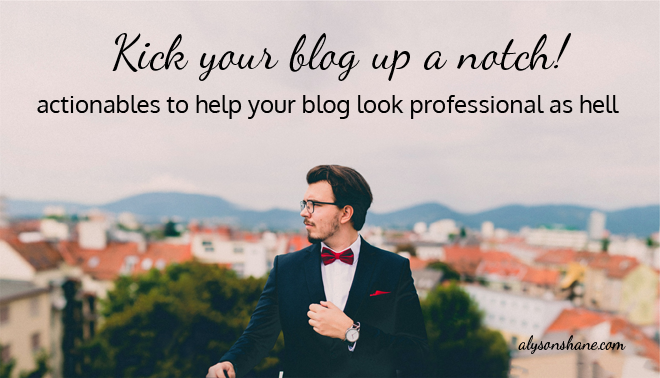
Clean up your layout
Remember the days of the early internet, back before we really thought about things like user experience and a clean, functional layout? If you don't, check out the Wayback Machine which is a handy little archive of what websites used to look like.
By and large they all sucked.
In fact, even my old layout kinda sucked. Let's take a look:
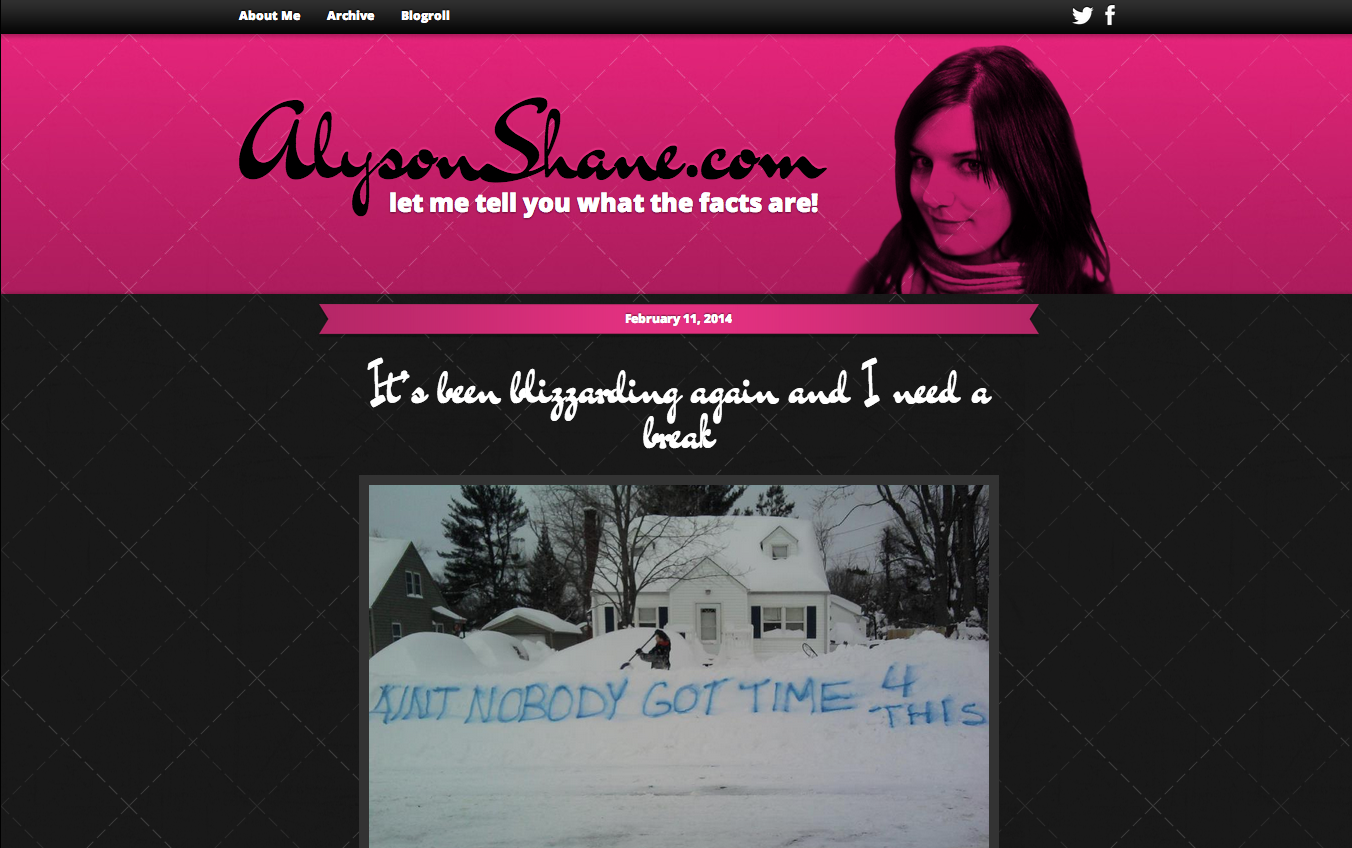
Ouch, right? Abrasive colours, no real flow, no real navigation... a very basic and (let's face it) pretty immature-looking site. Nobody visiting this website would have taken me for a professional creative-type.
This is because an abrasive, clunky-looking site demonstrates that you're not really serious about what you do; it immediately tells visitors to your blog you haven't put the time, energy and effort into making it represent you in the best way possible.
Not just that, but it shows that you aren't taking your visitor's experience into consideration, either - people won't stay on a site that's hard to read, especially a blog.
So what can you do? Here are a few steps that you can take to clean up your layout:- Stick to the basics. Darker text in a white or off-white background is easy to read and isn't painful to look at.
- Don't go font-crazy. Find a header font and a regular text font and stick to them. Google Fonts has some great free resources (thats's where both of mine, Dancing Script and Oxygen, come from)
- Rethink your layout. Visit your favourite blogs and make a list of the things that you like about them - what colours do they use? What sorts of layouts do they have?
- Need inspiration? Moodboard it out! I used Niice to create a mood board with design and style inspirations which helped guide my website re-design. You can check the one that I created here.
Get professional photos taken
Having nice, professional photos can make all the difference in how seriously people will take you and your blog. Selfies have their place, but that place shouldn't be on your sidebar or bio page!
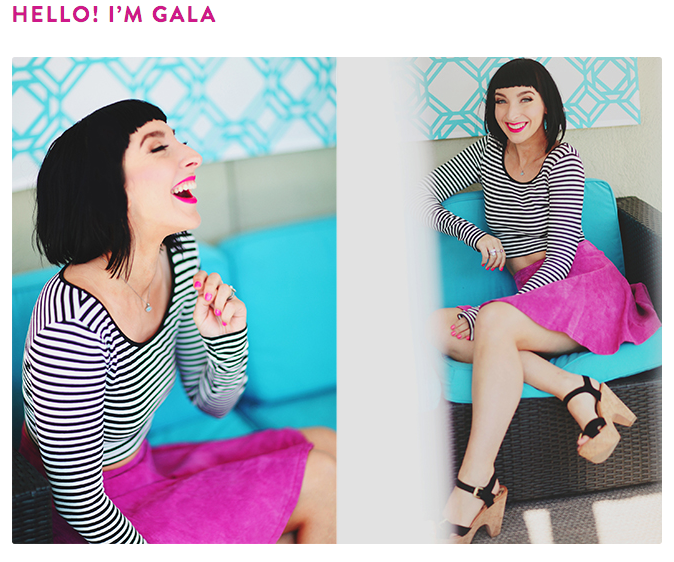 I've always loved Gala Darling's amazing photos; they really showcase her personalty and look stunning. You don't have to go high-fashion (or even pay through the nose for a professional session) though, just a decent camera and some good lighting makes all the difference!
I've always loved Gala Darling's amazing photos; they really showcase her personalty and look stunning. You don't have to go high-fashion (or even pay through the nose for a professional session) though, just a decent camera and some good lighting makes all the difference!
Shop around and see what local photographers are charging for portrait sessions; it might seem like a steep investment up-front but I guarantee you that having some beautiful, professional-level photos will not only make your blog look better, but you'll feel better about sending people to check it out.
(Shameless plug: my photos are via the super-talented Palma Photography. If you're in Winnipeg or the surrounding area I highly recommend working with him.)
Review brands & experiences you love
Many big-time bloggers do "sponsored" posts where a brand sends them a product, invites them to an event, or provides them with a free experience in exchange for coverage on their blog.
If you're just starting out this might seem daunting - how do you let brands know that you're ready, willing and able to start working with them? Easy: Write up a post reviewing a product or experience that you had and show them what you can do!
I don't mean lie about being sponsored by a brand, but rather simply write a review with some nice images or graphics (preferably ones that you made yourself, you clever thing.)

A great recent post in style that I recommend checking out is Sarah from Sunshine & Mint, who recently blogged about her natural skincare routine, and reviewed the products that she uses on a regular basis. It's that easy!
Additionally, make sure to link to any brands you mention in your post, and in any posts you create on social media! This means linking to their Facebook page in your Facebook post, @mentioning them on Twitter, etc. This dramatically increases the likelihood that the right people will not only see your post, but will want to work with you in the future. At the very least, an astute social media manager will share your post with that brand's audience, which will bring more people to your blog.
Include links to recent posts/projects
Whether someone is visiting your blog for the first time or is a longtime reader, making sure that they can easily find links to your other work is a great way to show off your content and increase engagement.
If you're a blogger with lots of projects, helpful content, or multiple-post series, consider creating a 'projects' page like I have, or link to the in your sidebar to help people find them (Ashley of A Silver Twig does a great job of this on her sidebar, in case you're looking for examples)
Other helpful stuff your blog should include is:
- Recent Posts section with links to your most recent content
- Older Posts or Archives section or list. I keep mine on my sidebar and it's organized by month, but lots of other bloggers like Tony Pierce put theirs at the bottom of their page.
- Projects or similarly-named page for longer, more in-depth projects. This serves as a place where readers can easily find and navigate around related posts.
- Footers linking to other related work, eg: "this post is part of a series, click here to see more!"
Make your social media links easy to find
Prominently displayed social media links encourage readers to interact with you across multiple social platforms - if they like your blog they're likely to start following you on Twitter, connecting with you on Pinterest, or wherever you may be.
Additionally, showcasing the multitude of ways that you're connected online also demonstrates how social media-savvy you are. Just make sure that you're linking to active profiles! Nobody wants to engage with a dead and forgotten profile.

Bonus: If your site layout allows for it, RebelMouse is a great widget which will pull all of your content from a social media feed (mine pulls my Twitter & Tumblr) and show it on a single page. I snagged this idea from blogger superstar Casie Stewart, who uses it as the landing page on her personal website, and I love how it looks.
Include a copyright in your footer
Even though you have a built-in copyright on original material that you publish online, a little copyright at the bottom of your page is a handy reminder that the content on your site is yours, and helps add a more professional feel to your content.
Include calls to action
An easy way to help people find your other posts, subscribe to your newsletter, or interact with your post is to include calls to action throughout your blog.
For example, there's a call to action at the bottom of my posts which looks like this:
I've written about the importance of newsletters in a previous post, but let me just say this: newsletters are one of the most powerful tools that you have to communicate with your audience.
This is because when people sign up for your newsletter they are saying "yes, I confirm that I want to hear from you on a regular basis!" and are granting you permission to send your content directly to their inbox. No worrying about social media algorithms, sites getting shut down, etc. You always have a way to communicate directly with your audience.
You can also include calls to action in the body of your posts by ending a post with a question, or series of questions meant to engage your reader and encourage comments. By asking questions or actively asking for suggestions, you show your readers that you want to interact with them and increase the likelihood that they'll comment, share or subscribe.
Share what you know (be a thought leader)
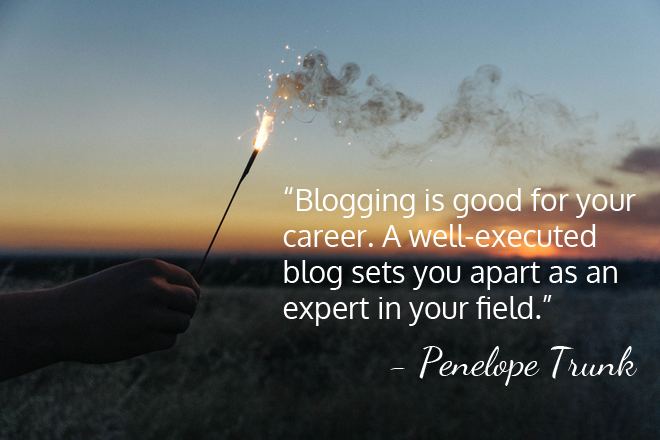
I love that quote from powerhouse (and one of my personal heroes) Penelope Trunk.
Blogging is about having something to say, and saying it well.
Don't just share what you know, share why you feel it's important knowledge. Be descriptive, be creative, and be daring. Think about the things that matter to you as a person, as a business owner, as a creative, whatever, and get writing about it.
Have you been building your business from the ground up? Blog about that. Do you have keen insight into B2B marketing? Blog about that. Have you built a mini internet empire painting watercolours of sloths? Blog about that!
Put yourself out there and show your audience who you really are - that's what will keep them coming back, after all.
Do you have any additional tips for making your blog better? Any horror stories of blog layouts past? I'd love to hear them!
Crowdfunding Crash Course: Guillaume Rolland - SensorWake
- by Alyson Shane

Guillaume Rolland is an 18-year old entrepreneur from Paris, France. He is the creator of SensorWake, an olfactory-based alarm clock which wakes you up through the power of smell. He used Kickstarter to successfully fund his project.
Can you briefly talk about SensorWake?
SensorWake is an olfactory alarm-clock. It can wake you up only thanks your favourite scent (hot croissant, peppermint, coffee and even the smell of a dollar!)
Why did you feel that the crowdfunding model was the best way to promote the product?
It’s the perfect worldwide showcase to promote your device or idea.
Why and how did you choose Kickstarter over other crowdfunding options available?
Kickstarter is developing the most powerful community; it is multicultural, curious, and respectful about your project.
How big was your budget before you launched your crowdfunding campaign?
We have to create a great video and great images of our product. We don’t communicate about it but we started with less than 10.000€
How far along was your project before you felt ready to launch a crowdfunding campaign? In hindsight, would you have preferred to be farther along, or to have crowdfunded earlier?
You have to begin the preparation about 4-5 months before.
Can you explain how you prepared for and managed your campaign?
We built a strong team and made sure everyone had strong, unique, and different qualities to be ready for all the challenges we expected.

What tools did you use to market your campaign? Do you feel like you did so successfully, and if not, what could you have done differently?
Facebook Ads are a really great key to market the campaign when it’s live. You also have to showcase your product at a real event. For example we attended the Hello Tomorrow Start-Up Village in June; it’s just the perfect way to demonstrate the real qualities of your product, and to meet your very first backers.
In retrospect what were your best assets for running this successful campaign? On the other hand, what would you do differently?
One of our best assets was that we had a strong community before the launch. We more than 7,500 fans on Facebook before the campaign launch, who were our very first ambassadors who promoted our project.
What was your biggest challenge during your campaign?
Our best challenge is to keep in touch with our backers, we have to be close with them but not spend too much time responding to every email or comment.
What’s the most valuable advice you could share with aspiring crowdfunders?
Take your time before launching, develop a strong community and create the perfect crowdfunding page, do not forget that video is 50% of your campaign success.
This post is part of the Crowdfunding Crash Course series. You can find the full list of interviews and summaries here.
Before & After Blogging: A Handy Post Checklist
- by Alyson Shane
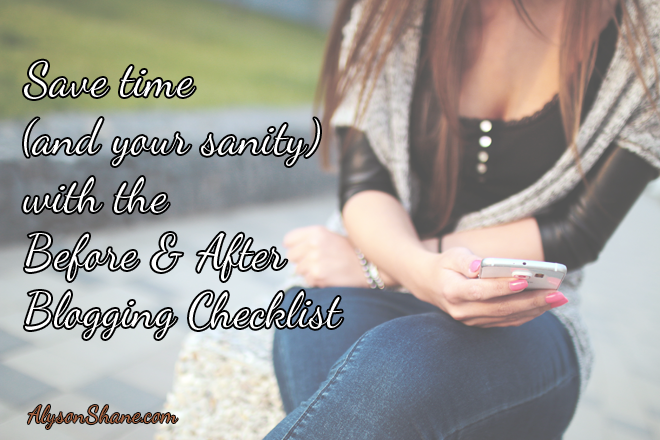
When I first started blogging (way back around 2003) things were easy. You wrote your post, hit 'publish' and other people's RSS feeds took care of the rest.
Nowadays things aren't so simple. Bloggers need to worry about things like search engine optimization, keyword inclusion, social media promotion, image design... the list goes on!
If you're new to blogging the amount of steps needed to make sure your post gets the attention that it deserves can seem really daunting, and even for a veteran blogger like me when things get crazy-busy it can be a challenge to make sure I'm taking all the necessary steps to promote my latest post.
With that in mind, I've put together a handy little resource for you (and me!) to use.
The Before & After Blogging Checklist is a simple little tool which helps keep track of the things to do before and after a post goes live. This helps me stay organized and on-track, and hopefully it will help you do the same!
You can view it here, or download it below for easy everyday use!
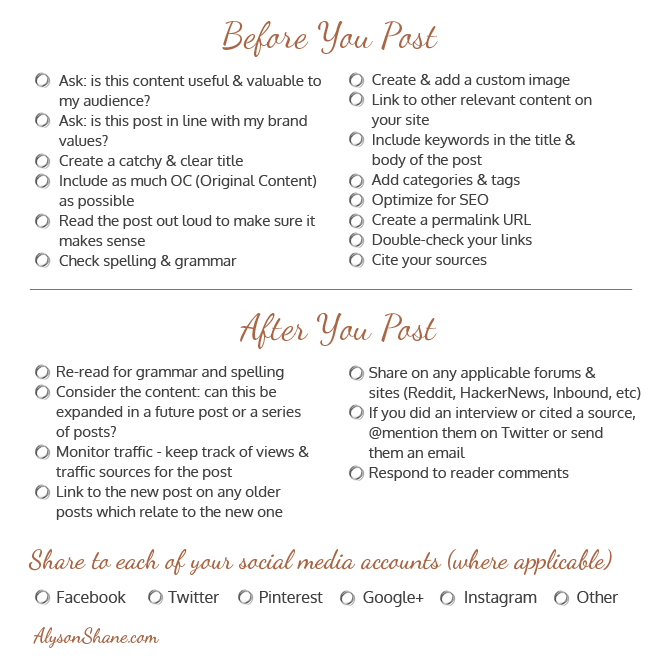
Want to keep a copy for yourself? Download it here:
Enjoy!
Crowdfunding Crash Course: Tomas Ericsson - Axess Front Wallets
- by Alyson Shane

Tomas Ericsson is the founder of Axess Front Wallets, a unique leather wallet designed to fit comfortably in your front pocket.
Can you briefly talk about Axess Front Wallets?
Axess came as a response to the fact that I couldn’t find a great front pocket wallet on the market. I started experiencing back pain when sitting on my bulky wallet two summers ago and that sparked the idea that eventually became Axess Front Wallets.
Why did you feel that the crowdfunding model was the best way to promote the product?
To be frank, it was due to the financial realities of the project; the materials are super expensive with a high minimum order quantity so I couldn’t go ahead with Axess without the Kickstarter. Kickstarter is also a great marketing platform with exposure to some 30 million monthly visitors, in addition to giving you those crucial early backers. It’s absolutely great, thanks Kickstarter! :)
Why and how did you choose Kickstarter over other crowdfunding options available?
I was actually going to go with Indiegogo when I started planning Axess, but then Kickstarter allowed Swedes to launch projects back in October last year, so it became a no-brainer; the Kickstarter platform, due to its limited allowed countries, and higher bar is a much more powerful crowdfunding platform. There’s more trust in a Kickstarter than in the alternatives, and they have much more traffic and paying customers.
How big was your budget before you launched your crowdfunding campaign?
I have spent quite a lot developing my product, but the marketing budget is just around $1,000 usd.
How far along was your project before you felt ready to launch a crowdfunding campaign? In hindsight, would you have preferred to be farther along, or to have crowdfunded earlier?
I was very far along, I had developed 18 unique models, and I had several great blog mentions and over 400 early subscribers on my landing page. I think I launched in just the right moment.
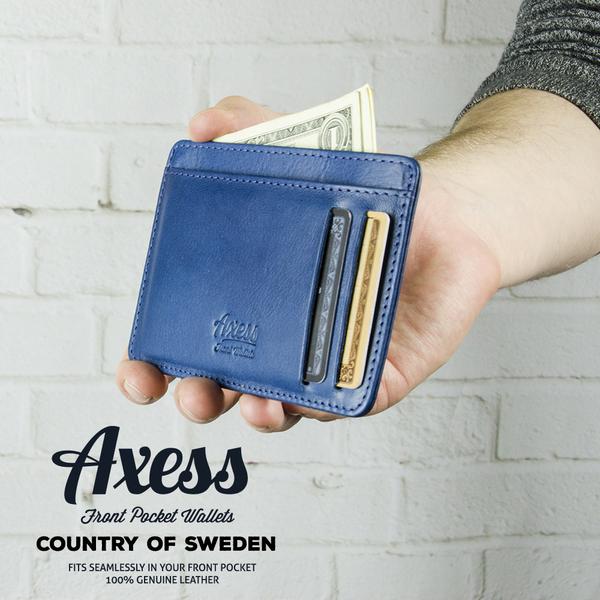
Can you explain how you prepared for and managed your campaign?
I had a landing page which I promoted on Reddit and then later on via getting featured in big fashion blogs, and I gathered 400+ emails in a couple of months. I created Facebook, Twitter and Instagram accounts and let everybody I knew know that something was stirring north of the wall!
What tools did you use to market your campaign? Do you feel like you did so successfully, and if not, what could you have done differently?
I used Unbounce to build a landing page which works really well (albeit being a bit pricy). I got help from a consultant from P&G I met accidentally on Reddit /r/advancedentrepeneur who actually built the landing page for free. For my Reddit promos I used an Imgur account, that’s a must. My biggest mistake was to not include social sharing buttons anywhere on my landing page
In retrospect what were your best assets for running this successful campaign? On the other hand, what would you do differently?
My own promotions on reddit and via email to blogs was the key, just straight forward emails to people, my own simple promotions were the biggest asset, (as well as the P&G consultant who built my landing page)
What was your biggest challenge during your campaign?
Taking all the product photos and making all the GIF-animations without breaking my back. (Gin and the Joe Rogan podcasts helps a lot during long photo days in the home studio),
What’s the most valuable advice you could share with aspiring crowdfunders?
Try not to take any shortcuts when developing the product or service, try to find an opening in the market (don’t attack something head on, go for a smaller piece of a more specialized part of the market). Read business literature, I recommend all of Al Ries books and Jim Collins books, those really put me in the right direction.
This post is part of the #CrowdfundingCrashCourse series. You can find the entire series of interviews and summary posts here.
Winnipeg Folk Fest: My Favourite Temporary Community
- by Alyson Shane
Hello everyone!
It's been a while, hasn't it? I've been away for the past week or so at the Winnipeg Folk Festival and I'm just getting back into the swing of things today.
For those of you non-festival-goers and non-Winnipeg locals, the Winnipeg Folk Festival is a massive four-day music festival which takes place in Birds Hill Park, one of our beautiful provincial parks. Some people just go for the day, but many of us (myself included) make the trek 45 minutes outside the city to be able to camp in their massive, sprawling campground.
Going to Folk Fest feels like coming home. Every year as I haul my camping gear up the trailhead and see the wide expanse of the festival, with it's multitude of tents, signs, posters, bikes, and decorations my heart starts to flutter and I feel so at peace.
It got me thinking about the beauty of temporary communities.
In university I read a fascinating paper called "In Search of How Societies Work: Tribes - The First and Forever Form" by David Ronfeldt that has always stuck with me. It was one of the first papers that I'd read which got me thinking about how, even in our digital age, we still network and search for "tribes" online that we can connect with: we find Facebook groups, join Twitter chats, and customize our subreddits to help us find communities that we can connect with and which give us a sense of belonging.
As a content marketer, communities are my game. I nerd out about community-building and people coming together to share positive stories and experiences online on a daily basis, and being able to apply that same sense of wonder and excitement to a going camping for a few days is a truly unique experience.
From the moment I set foot in the campground, I feel like I'm among friends; my own kind, who are all there to enjoy the summer, the music, the campground festivities and activities, and each other. We're all friendly, respectful and kind to one another; it's not uncommon to wander by a campsite and join in for a few songs, or make friends while waiting in line for some wood-fired pizza at the food vendors, or simply to wave and say 'hi' to someone whose costume makes you smile.

I'm part of another community at Folk Fest as well: the volunteer crew. Every year over 3,000 volunteers handle everything from security, to environmental clean-up, traffic, first aid, making and distributing food... you name it, there's likely a volunteer to handle it. We spend time training together, getting to know one another, and sharing in the long nights and blazing hot days of our shifts. We make friends with our crew members and the campers are so incredibly kind to us when we're on our shifts; it's not unusual for a random camper to shout out "you guys are doing a great job!" to us as we walk around the campground making sure everyone is having a safe and positive festival experience.
I've been to a handful of festivals in my lifetime but none of them have the same sense of shared respect and camaraderie that I feel at Folk Fest.
The anticipation of going makes me part of another community, as well: many people (myself included) see the festival as one of the highlights of our year, especially here in Winnipeg where our climate can be extremely harsh. Our winter temperatures can plummet to below -40 celsius and stay that way for weeks on end, and our summers can soar to over +40 celsius as well.
We truly experience the full range of seasons here, and many a long winter night is spent daydreaming about warm temperatures and, for many of us, the experience of camping at Folk Fest. I'm not kidding when I say that people live to go camping at this festival and take part in the temporary community that exists for a few short days each year:
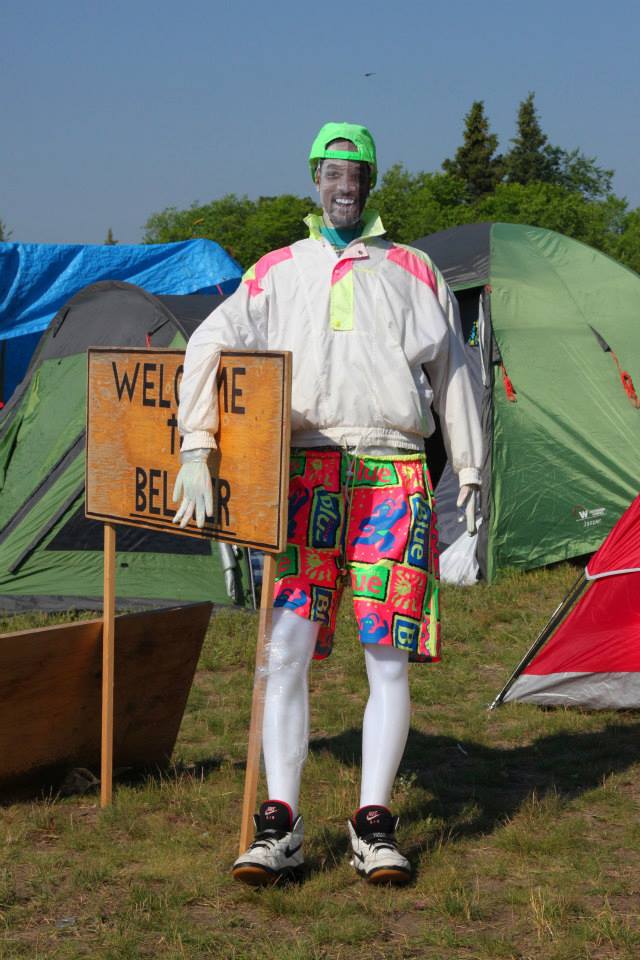
People haul in all sorts of weird stuff and set up the weirdest camps, from a temporary tattoo parlour which will create custom designs for you, a Jurassic Park themed camp with huge dinosaurs and torches, a Peanuts themed camp complete with Lucy's psychiatric help booth, to freakin' Bel-Air with a Fresh Prince mannequin, people really do go all-out in order to contribute to this magnificent, temporary community. The sheer amount of effort and love that they put into making the campground experience a unique and positive one for everybody is truly inspiring.
In addition to all the amazing communities that I get to help build and watch grow as part of my work, my day-to-day activities online, and this blog (thank you for reading, as always!), being able to be a part of the multitude of communities at Folk Fest always leaves me feeling so inspired and, of course, dreaming up ways that I can contribute next year!
Do you have any favourite communities (online or offline?) If so, I'd love to hear about them!
Twitter for Beginners Part 3: Finding Your Voice, Curating, Chatting & Analytics
- by Alyson Shane
Welcome back to the third installment of my Twitter for Beginners Series!
So far we've learned:- Some basic Twitter terminology
- How to set up your profile
- Finding and gaining followers
- Tweeting, replying and starting conversations
- What to do if someone is harassing you (muting & blocking)
- Making the most of Twitter's Tailored Trends feature
This final chapter will go more in-depth about how you can build your brand on Twitter, how to find and share great content, defining your tweeting 'style', and building a kickass network of people and brands that care about you.
So without further ado, let's get started!

Develop Your Voice
Whether you're tweeting from a business account or just trying to grow your own reputation online, what you say and how you say it will play a defining role in your success. Because social media can seem very simple to do, many people start blindly and try to develop their voice as they go.
While this is certainly okay, it's much more prudent (and time-saving) to sit down and ask yourself some basic questions about who you are, and how you can best convey that information online.
Some questions to ask are:
- Who are you?
- What are your goals?
- How do your Tweets support and further the above statements?
My answers would look like this:
- Alyson Shane, kickass content marketer & copywriter
- To grow my audience, work with great clients, and have a positive impact
- By sharing interesting content, engaging with my community and putting a heavy focus on local events and causes
If you're a small business owner yours might look like this:
- Babe McBaberson, DIY wizard and crocheter of charming baby clothes
- To drive traffic to my new website and generate sales
- By connecting with influencers, bloggers and other DIY-ers like myself to build a strong public profile
You get the point. The key to developing a strong voice online is to know who you are, what your goals are, and how your tweets help you further those goals. Your tweets and the content you share are a reflection of who you are, so always be mindful of what you say.
It's okay if you don't know this stuff right away. It might take a few days, weeks, or even months before you really have a solid idea of how your tweets can be the best that they can be, but the trick in the interim is to keep tweeting. Don't be paralyzed by indecision! When in doubt, be conversational, kind, polite, and share your work.
Curate Your Content (and Find Interesting Stuff)
Churning out interesting, funny, retweet-able content on a regular basis might seem like a breeze, but if you're just starting out it can seem like an insurmountable mountain of websites and jpegs.
Of course, sharing your own work and website content is important, but the trick is to pepper it in-between tweet replies, retweets, and sharing articles and images that help your followers get a sense of who you are. The aggregate of the content you tweet out is how people will start to develop an understanding of who you are, and that's what will make them care about you (and your product or business).
Here are some tips to get you started:
Maximize Lists:
Twitter has a great 'List' feature, which allows you to separate people that you follow into public or private lists that you can quickly scan for new content. The difference between a private and public list is, of course, than other people can see your public lists, but Twitter will also notify users when you add them to a list, as well.
By organizing people that you follow into relevant groups (eg: affiliate organizations, local businesses, influencers, etc) you can scan huge swaths of people that you follow quickly and easily, and reduces the likelihood that you'll miss an important tweet from someone you care about.
The downside to lists is that it can be a slow, manual process (believe me, I've curated lists for myself and various clients more times than I can count) but the time that your future self will save is 100% worth the effort.
Use a Curation Tool
Many people choose to use a content curation tool, which allows them to collect a variety of different content (blog posts, videos, images, etc) and publish it in a single place at once. This can accomplish a few different goals: it can tell "stories" which are centred around a particular theme, it can work as an aggregate of a variety of different topics in a newspaper-style format.
The upside to using a tool like this is that you can organize content as you find it and the tools will provide up-to-date versions for your audience to access. You can also use these tools to publish daily "newspapers" of content, such as with Paper.li, which will @mention people whose content you've included in your collection.
There are a few different flavours of content curation tool, but here are a few popular ones:
Paper.li: You may have noticed that some of your Twitter followers will have tweets that read like: "The So-and-So Daily is Out!" - this is a tweet created using Paper.li. This tool allows you to create daily or weekly "newspapers" with content from Twitter users, you and the people you follow, or certain hashtags. Paper.li publications aren't permanent, however.
Storify: This platform features live story updates from content sources selected by you using a drag-and-drop editor. The single-editor experience works okay, but when you purchase their enterprise plan (surprise, surprise) the multi-editor experience becomes a lot more useful. You can add your website as a custom 'source' which includes your site's content in your Story.
Upcoming: Twitter recently introduced a 'Curator', a single platform for live engagement, real-time trends and displaying Tweets which isn't open to public use, yet. I'll be covering it in an upcoming post once it's available publicly and I've played around with it a bit!
Lean on Curation Sites:
This is one of the best tricks I've picked up since I started taking content marketing seriously. It can be extremely time-consuming to troll around various websites looking for content that's relevant to you or your brand, and checking these sites a few times a day can save tons of time and effort.
Here's a list of a few that I like:
- PopURLS
- AllTop
- HackerNews
- Reddit (You can curate customized subreddits specific to different topics)
- Inbound
- BloKube
While these might not be perfect for you (some are obviously a bit more tech-related than others) ones like PopURLs, Reddit and AllTop have a wide variety of topics and flavours to suit whatever you're looking for. Using these sites to quickly and easily find fresh content to share is such a huge time-saver!
Make the Most of Twitter Chats
Like the name implies, a Twitter chat is a large, group conversation hosted on Twitter. There are thousands (at least) of Twitter chats which range across a wide variety of trends, topics, and ideas and are organized by hashtags, which we talked about in the first post in this series.
Moderators who organize the chats generally ask questions to the people participating, who then reply and respond to each other, but there are less formal versions of Twitter Chats which can simply be organized around a central theme or topic.
In order to actively participate in the chat you must include the chat-specific hashtag in the body of your tweet. This allows other users who are participating and searching that hashtag to see your replies, and to respond if they want.
Here's an example of a question/reply from a Twitter Chat I participated in a while back:

Twitter Chats allow you to access vast networks of other people in your industry, or who are interested in the type of work that you do. It's a super easy easy to find out what other people are thinking and feeling about different topics, to gain insight into issues relevant to what you do, and simply to find new people to follow.
You can find chats relevant to your interests by using tools like Tweetreports, TweetChat or simply following industry leaders who host them, or ask others that you know what chats they like to participate in.
Customize Using Third-Party Tools
One of the great things about Twitter is that it's been around long enough that there are a lot of different options, both on desktop and mobile, to help you manage your content. However, there are a lot of options for different operating systems, so here's a list of a few of the popular ones out there:
Twitter App: Standard, regular 'ol Twitter, available across all platforms. This is great if you're just getting started and don't need a lot of customizable features. It has account switching, so if you're managing more than one account you won't feel left out.
However, you're also at the mercy of promoted tweets, changes to the chronological listing of tweets, pictures appearing in-stream by default, and a multitude of other things that can get annoying if you're spending a lot of time on the platform. However, as I said, it's great to just get your feet wet.
Here's what's available on each platform:
On iOS: Tweetbot, Übersocial, Tweetlogix, or Janetter.
On Windows: MetroTwit.
On Linux: Choqok, Birdie or Polly.
On Android: Übersocial or Janetter.
On Blackberry: Übersocial.
I also use a web-based program called Hootsuite, which helps me organize and schedule tweets in advance. This tool (or a similar competitor, Buffer) allows you to organize what you want to see into columns and to schedule tweets, which is really helpful if you know you have content that needs to be promoted in the future, or if you've got a lot of content that you want to distribute over an extended period of time.
Pay Attention to Your Analytics
So now you've found your voice, your community, and you're tweeting, sharing, and participating in chats on a regular basis. Great! But it doesn't mean anything if you don't understand how to leverage what you're saying.

Analytics can help you determine a variety of things, including:
- How many times you tweeted in the past 28 days
- Total tweet impressions, and impressions per tweet
- If interaction with your followers has changed
- What types of content gain the most interaction
- When your followers interacted with your content
- Who your top followers are
- What your followers are interested in
The tweets dashboard is your hub for understanding how your outgoing tweets are doing. You can quickly see your most popular tweets, how many people they reached, and the level of interaction each tweet received. You can also see your daily tweet activity as well as how many follows or unfollows you had in a single day.
By paying attention to the days which showed the best performance you can which tactics to apply to your tweet schedule, and which days are the most effective. You can also compare previous months to see how your tweets do over time, determine the best types of content to share, and so much more.
Twitter analytics might seem overwhelming at first, but it's your best tool for understanding how and when to connect on Twitter.
Your turn!
In the span of three blog posts we've learned how to understand Twitter, how to get started, and how to use this powerful social network to grow your online profile and attract attention and interest to you and your business.
Make sure to follow me on Twitter so we can stay connected, and if there's something else that you'd like me to cover, or a burning question that you'd like answered, drop me a line! I'm planning tons of content like this series and if I can cater it to what you need, even better!
Happy tweeting!
Alyson S.
This post is part of the three part series on Twitter for Beginners. Make sure to read part one and part two as well! The entire series can be found here.
Crowdfunding Crash Course: 5 More Lessons Learned
- by Alyson Shane
The Crowdfunding Crash Course is chugging along and I'm amazed at the overwhelming response from participants and readers alike - I'm learning so much, and am loving the journey of sharing interesting and innovative projects with all of you.
With that in mind, let's review some of the key themes that have emerged over the responses so far and see what we've learned:
1. Organize your team before you start
Kelly Stacey of SoLight, who funded their product SolarPuff on Kickstarter, mentioned that keeping up-to-date with backer questions and special requests was especially taxing. "We had a lot of people asking a lot of questions and getting back to all of them (and we did) was very time consuming" she says, and she isn't alone: every single person I've interviewed has mentioned the tremendous level of organization required to run a successful campaign.
Randy Hoyt, who successfully funded two tabletop games, Relic: Expedition and Lanterns: The Harvest Festival on Kickstarter, took the first and last day off work to make sure that he was available to handle all questions and issues that might come up. "The first and last days of your campaign are the busiest" he says.
The takeaway: if you don't feel like you can handle the planning and execution of your campaign, hire someone or organize a team of people to help you with it. Even things as seemingly simple as responding to backer emails, or interview questions can take up a lot of time, and by delegating and being organized you can make sure you're focusing on what matters: making sure your project is fully funded.
2. Tap into your existing audience
Randy Hoyt from Foxtrot games use the momentum from their first tabletop game, Relic: Expedition to build momentum for their next game Lanterns: The Harvest Festival. They had an existing mailing list from the first Kickstarter which they used to spread the word to people who they already knew were interested in tabletop games, and who had already helped fund the earlier project. Meg from Po-Mo, who funded the interactive projector Lumo on Indiegogo, also tapped into her existing email list to spread the word about their campaign.
When Nils Karlen launched his Kickstarter for Simon Stålenhag's two art books Tales from The Loop and Swedish Machines, Lonely Places, he knew that Simon already had a tremendous following online that they could tap into in order to get funding. Fria Ligen used their own networks to promote the project, but what put them over the top was that Simon leveraged his social media channels and his Tumblr to promote it.
The takeaway: if you have an existing audience, or are working with someone who does, reach out to those people first and let them know about your project. If you don't, spend the time before you launch to build an email list, Facebook page, and Twitter following so that people across multiple social channels can stay up-to-date with your progress.
3. Turn funders into contributors
During his first Kickstarter for Relic: Expedition, Randy Hoyt was hesitant to share the script and rough storyboard for the video with his audience. The second time around, he says, he "realized that feedback was so important" and posted the rough storyboard on YouTube and shared it on Twitter and Facebook so that he could get people's feedback. He also allowed backers to vote on different variations of artwork for Lanterns: The Harvest Festival, which increased engagement and excitement about the project.
The takeaway: By offering backers the opportunity to give their input on things like artwork and design you give them an added incentive to back your campaign: not only are they getting a cool product if your campaign meets its goals, but they also get to participate in the creation of something that interests them.
4. Plan your pledge levels for greater success
Nils Karlen mentioned that during his research for Simon's books that they found that having a very low pledge level (a dollar or two) was an important step to get the campaign started because Kickstarter's metrics consider ever pledge, no matter how big or small.
They also used early bird pledges to incentivize people to start donating early (an early bird pledge is a limited pledge level that is strictly better in terms of price than a comparable level.) By offering limited-time options it mobilizes backers early on, and it also gives you opportunities to promote the campaign by appealing to this sense of urgency eg: "only two more days of our Early Bird $10 option!"
The takeaway: It might seem tempting to only offer pledges at higher dollar values because it will feel like getting closer to your goal faster, but remember that everyone who contributes to your campaign will likely spread the word about it, as well, and you don't want to alienate potential backers by only offering expensive options. Try to create a pledge system with rewards and dollar amounts that appeal to everyone.
5. Don't get discouraged
There will be slow days, no-news days, and days when everything feels as though it's come to a grinding halt. This is normal. What's important is to stay motivated and think realistically, and use those "down" days as days to find other ways to stay motivated and positive about your project.
Tamar Swartz, who used Indiegogo to fund her project Journey to Creative Surrender, mentioned in her interview that she had to remind herself that contributions come in waves, and just because there's a lull doesn't mean that there's a reason to get discouraged, and Mike Raven mentioned in his Traveling Book interview that he also struggled to stay motivated in between donations.
The takeaway: Don't let a slow day get you down! It's totally normal to get stressed out or feel anxious if your project isn't funded within the first few days, but as long as you stick to your promotional schedule and continue to do things like respond to emails, send out updates and stay active on social media you'll soon see another surge of backers.
This post is part of the #CrowdfundingCrashCourse series. You can find the entire series of interviews and summary posts here.

